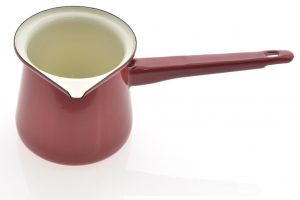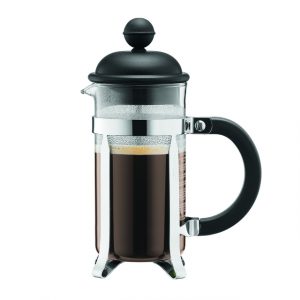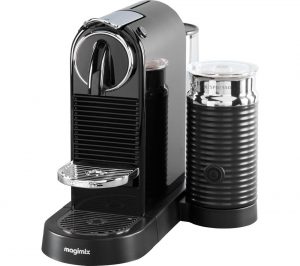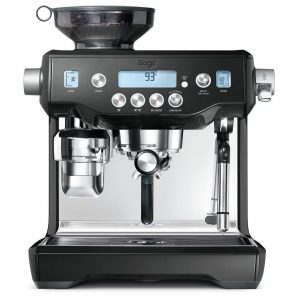

We are sometimes asked by business owners for advice on how to improve the quality of their product and there is no short answer but to get you started in the right direction here are what we think are three key points.
1. Adequate, regularly cleaned and maintained equipment. By adequate we mean powerful enough to keep the water coming through at the set temperature during times of peak demand, if you draw water faster than the machine can heat it then the temperature of the water coming into contact with the coffee drops and the quality will suffer badly.
A small restaurant will be fine with a basic single boiler machine but a large busy takeaway coffee shop will need a much more heavy duty, multi boiler, multi head setup. Grinders are similar except for the fact that if you use them too hard they heat up rather than cool down, what this does is heat the coffee before it gets to the hot water which again impacts the taste. While we are on the subject of grinders, an on-demand rather than dosing grinder is preferable for several reasons.
Regular maintainance is important (and also a legal requirement) for these high pressure bits of kit and regular cleaning is not only good practice from a hygiene point of view but also prolongs the life of your equipment.
2. Fresh, suitably roasted, good quality beans. Coffee (like any other foodstuff) tastes better when fresh – pretty straightforward. Bean selection is beyond the scope of this article but you should talk to your supplier and ask about where the beans came from although the taste is a pretty good indicator of quality assuming they have been prepared well. Certifications such as organic, rainforest, and fairtrade vary so much that it is worth educating yourself about them.
When we talk about the degree of roast we are basically saying how dark they are, the southern mediterranian way of roasting is almost or actually black with the oils on the surface of the bean, we feel that is too far and roast to a lighter degree to keep the oils in the bean until the time comes for them to be made into your cup of coffee. At the end of the day this comes down to personal taste but the speciality coffee market rarely uses such dark roasts.
3. Well trained and motivated staff. The best beans and equipment mean nothing without skilled use. Your staff must be capable of reliably extracting coffee to fairly tight tolerances all day, recognise when settings need to be changed, and be capable and confident to adjust variables such as grind, tamp, and dose as necessary all while keeping up with demand. It’s not an easy job and that is where the motivation comes in – well trained staff who feel valued and are proud to serve quality products will strive to keep the quality up on a busy day.
We hope this answers a few questions and hopefully it has raised some more, get in touch and we can answer those too.
How you grind the coffee really makes a difference to the final result, here’s a quick cheat sheet to get you pointed in the right direction.
Essentially the longer you leave the coffee in the water the coarser it has to be to extract all the good stuff and a minimum of the bitter stuff.
Experimentation to get the best results is part of the fun but click on the guide below for a good starting point.
There are lots of ways to make coffee, here are a few recommendations if the list of options is getting a bit too much.
Contrary to popular opinion, the most complex and expensive ways of making coffee will not necessarily give the best results and importantly everyone is different, our advice is to try a few different methods and see which you prefer.
We will start with the simplest and work our way up.
 1. Turkish coffee pot or Jezva:
1. Turkish coffee pot or Jezva:
These are not so popular in the UK but near ubiquitous in Eastern Europe. Simply an enamelled pot with a pouring spout and a long handle so it doesn’t get too hot. They are very simple to use, you just heat water in them and when it’s nearly bubbling throw in some very finely ground coffee and wait until it starts to boil over, then remove from heat and return until it boils again which is usually only a few seconds.
That’s it, give it a little while for the coffee to sink and pour into cups, sometimes you get a bit of coffee grounds in the bottom of the cup but if this really bothers you just pour the coffee through a tea strainer.
Very quick and easy but it’s important to use very finely ground coffee otherwise it’ll taste off.
2. Cafetiere or French press:
Probably the most common method in the UK is the cafetiere. Simply warm up the pot before you use it and add coarsely ground coffee with just below boiling water. This is good for releasing delicate flavours but the coffee can over-brew if you leave it too long.
We are often asked how much coffee to use and the answer is of course however much makes it at the strength you prefer but a good starting point is 60g of coffee per litre of water (so 30g for a 500ml pot, 15g for 250ml etc)
 3. Filter or V60 method:
3. Filter or V60 method:
These used to be very popular and are coming back, a simple up-side down pyramid shaped bit of plastic that you put a disposable paper filter into and pour water in. The things to remember here are a medium grind, and water that is a bit below boiling.
The same ratio of coffee to water as above works for filter.
4. Pod machines:
Pod machines are those fancy things you have seen being advertised by George Clooney. You drop in a small plastic pod of coffee and press a button which dispenses a shot of espresso. Quick and easy to use but create quite a bit of waste and not cheap. You also have no idea how old the ground coffee is.
 5. Espresso machines:
5. Espresso machines:
Espresso machines are becoming much more popular and you can buy smaller machines for home use now. This method uses very high pressure water to extract the flavours from the coffee. You will want to use different coffee and grind it up finer than for the cafetiere but with this system you can make a wider range of interesting coffees like latte or cappuccino (once you master the milk frothing bit).
If you decide to go for one of these make sure you have a good quality grinder and someone to show you the ropes, it’s very easy to get vile tasting coffee from an espresso machine if you don’t quite have the knack.
Whatever you choose make sure you have fresh beans and the correct grind for the method you’re using, the ideal water temperature for making coffee is low to mid 90s so let the kettle boil and then sit for a minute or two so you’re not scorching the coffee.
If you’d like to try out all these methods with a range of different coffees, just come and see us.
You can buy our coffee direct from us in the shop at 23 High st Selkirk, online through the website or from the following shops:
Kelso. One Basket on the horsemarket or Cream chimneys on the square.
Lauder. Weigh Greener on the main st.
Galashiels. The Coffee Tree on market street.
Hawick. Land of Tastes on commercial road.
Peebles. Milne and Pickles, Northgate.
We are working on making it available in more places, please let us know if you have any recommendations.